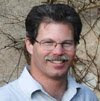The Gallery cases are definitely taking shape at a better pace now. Through a stroke of very good luck, and very generous new neighbors, I have been able to store all the parts and completed cabinets right next door to my shop. At first the extra 400 sq. ft. seemed plenty generous,
but even with fewer than half the cabinets, its filling up quickly!
Progress has been pretty good since the last blog entry. The three credenzas were the first cases to be assembled. These were constructed using a technique called floating tenons. In a nutshell, matching mortises are cut in the various mating parts, then a matching tenon is inserted upon glue-up. These were made using Festool's
Domino mortiser. After the parts were all mortised, they were taped to catch as much glue squeeze out as possible...
Then all it took was gluing in several dozen little Domino tenons and getting them all to line up all at once! The trick in this kind of construction is to get good clamping pressure all the way across the joints. For this an arc-shaped clamping caul is a real life saver. A caul is piece of wood used to spread clamping pressure more evenly across a joint. You can see from the highly technical schematic diagram on the caul itself that one face is left straight, while the other is planed to have a slight arc; in this case, about a 16th to 3/32 inch at each end.

When the curved face is put against the work piece and clamping pressure is applied at the ends, the caul bows applying even pressure across the entire case width, without having to have deep-reach clamps.
The credenza cases are now off at the finisher's, and will get their drawers and doors fitted after finishing.
With those out of the way, it was time to dive into the curved display cases.
One of the big challenges of the display cases is ensuring uniformity, so that when installed next to each other, all the doors, drawers, etc., line up just right. To make that easier, positioning jigs were made from scrap MDF. These were simple square spacers made to help locate each part relative to the others before being joined....
Once all the flat pieces were joined, the double-thickness curved front piece was attached....

Once the basic case assembly was completed, the curved front was trimmed flush with the sides and the outer curved layers were added. Each case has two outer layers, each with a wave-form shaped edge. The process for each layer was the same, and included first trimming the layer to length, then cutting the wave shape, fairing the cut edge by hand (these steps were done with the work piece strapped to the original bending form for ease of handling), then finally gluing it on and applying band clamps....

Mounting of the two outer layers has to be done in the same order that the cases will be installed, so that when installed the wave shape flow smoothly from one cabinet to the next....
Two down, nine more to go!











